-
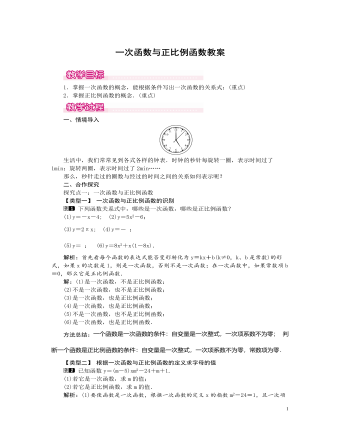
北师大初中数学八年级上册一次函数与正比例函数1教案
煤的价格为400元/吨,生产1吨甲产品除需原料费用外,还需其他费用400元,甲产品每吨售价4600元;生产1吨乙产品除原料费用外,还需其他费用500元,乙产品每吨售价5500元.现将该矿石原料全部用完,设生产甲产品x吨,乙产品m吨,公司获得的总利润为y元.(1)写出m与x的关系式;(2)写出y与x的函数关系式.(不要求写自变量的取值范围)解析:(1)因为矿石的总量一定,当生产的甲产品的数量x变化时,那么乙产品的产量m将随之变化,m和x是动态变化的两个量;(2)题目中的等量关系为总利润y=甲产品的利润+乙产品的利润.解:(1)因为4m+10x=300,所以m=150-5x2.(2)生产1吨甲产品获利为4600-10×200-4×400-400=600(元);生产1吨乙产品获利为5500-4×200-8×400-500=1000(元).所以y=600x+1000m.将m=150-5x2代入,得y=600x+1000×150-5x2,即y=-1900x+75000.方法总结:根据条件求一次函数的关系式时,要找准题中所给的等量关系,然后求解.
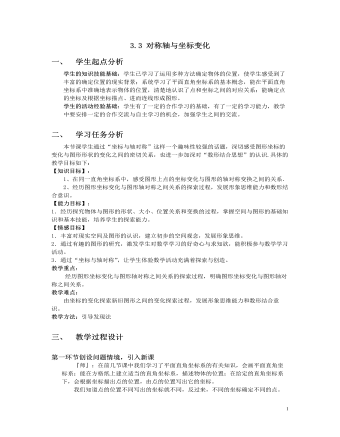
北师大初中数学八年级上册轴对称与坐标变化2教案
8.一束光线从点A(3,3)出发,经过y轴上点C反射后经过点B(1,0)则光线从A点到B点经过的路线长是( )A.4 B.5 C.6 D.7第四环节课堂小结1、关于y轴对称的两个图形上点的坐标特征:(x , y)——(- x , y)2、关于x轴对称的两个图形上点的坐标特征:(x , y)——(x , - y)3、关于原点对称的两个图形上点的坐标特征:(x , y)——(- x , -y)第五环节布置作业习题3.5 1,2,3四、 教学反思通过“坐标与轴对称”,经历图形坐标变化与图形的轴对称之间的关系的探索过程, 掌握空间与图形的基础知识和基本技能,丰富对现实空间及图形的认识,建立初步的空间观念,发展形象思维,激发学生对数学学习的好奇心与求知欲,学生能积极参与数学学习活动;积极交流合作,体验数学活动充满着探索与创造。教学中务必给学生创造自主学习与合作交流的机会,留给学生充足的动手机会和思考空间,教师不要急于下结论。事先一定要准备好坐标纸等,提高课堂效率。
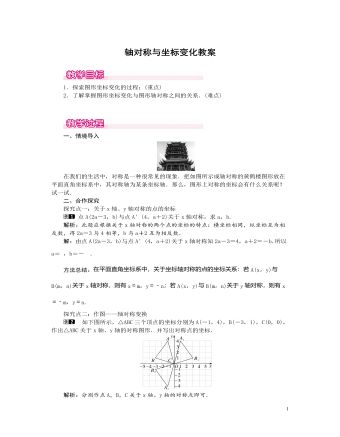
北师大初中数学八年级上册轴对称与坐标变化1教案
解析:从各点的位置可以发现A1(1,0),A2(1,1),A3(-1,1),A4(-1,-1),A5(2,-1),A6(2,2),A7(-2,2),A8(-2,-2),A9(3,-2),A10(3,3),A11(-3,3),A12(-3,-3),….仔细观察每四个点的横、纵坐标,发现存在着一定规律性.因为2015=503×4+3,所以点A2015在第二象限,纵坐标和横坐标互为相反数,所以A2015的坐标为(-504,504).故填(-504,504).方法总结:解决此类题常用的方法是通过对几种特殊情况的研究,归纳总结出一般规律,再根据一般规律探究特殊情况.三、板书设计轴对称与坐标变化关于坐标轴对称作图——轴对称变换通过本课时的学习,学生经历图形坐标变化与图形的轴对称之间的关系的探索过程,掌握空间与图形的基础知识和基本作图技能,丰富对现实空间及图形的认识,建立初步的空间观念,发展形象思维,激发数学学习的好奇心与求知欲.教学过程中学生能积极参与数学学习活动,积极交流合作,体验数学活动的乐趣.
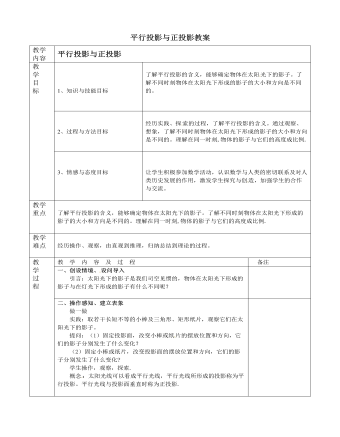
北师大初中数学九年级上册平行投影与正投影2教案
四、范例学习、理解领会例2 某校墙边有甲、乙两根木杆。已知乙木杆的高度为1.5m.(1)某一时刻甲木杆在阳光下的影子如图5-6所示,你能画出此时乙木杆的影子吗?(用线段表示影子)(2)在图中,当乙木杆移动到什么位置时,其影子刚好不落在墙上?(3)在(2)的情况下,如果测得甲、乙木杆的影子长分别为1.24m和1m,那么你能求出甲木杆的高度吗?学生画图、 实验、观察、探索。五、随堂练习课本随堂练习 学生观察、画图、合作交流。六、课堂总结本节课通过各种实践活动,促进大家对内容的理解,本课内容,要体会物体在太阳光下形成的不同影子,在操作中观察不 同时刻影子的方向和大小变化特征。在同一时刻,物体的影子与它们的高度成比 例.
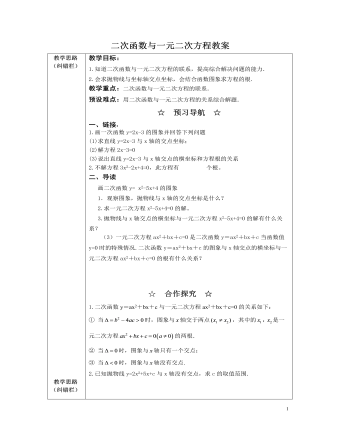
北师大初中九年级数学下册二次函数与一元二次方程2教案
教学目标:1.知道二次函数与一元二次方程的联系,提高综合解决问题的能力.2.会求抛物线与坐标轴交点坐标,会结合函数图象求方程的根.教学重点:二次函数与一元二次方程的联系.预设难点:用二次函数与一元二次方程的关系综合解题.☆ 预习导航 ☆一、链接:1.画一次函数y=2x-3的图象并回答下列问题(1)求直线y=2x-3与x轴的交点坐标; (2)解方程2x-3=0(3)说出直线y=2x-3与x轴交点的横坐标和方程根的关系2.不解方程3x2-2x+4=0,此方程有 个根。二、导读画二次函数y= x2-5x+4的图象1.观察图象,抛物线与x轴的交点坐标是什么?2.求一元二次方程x2-5x+4=0的解。3.抛物线与x轴交点的横坐标与一元二次方程x2-5x+4=0的解有什么关系?(3)一元二次方程ax2+bx+c=0是二次函数y=ax2+bx+c当函数值y=0时的特殊情况.二次函数y=ax2+bx+c的图象与x轴交点的横坐标与一元二次方程ax2+bx+c=0的根有什么关系?
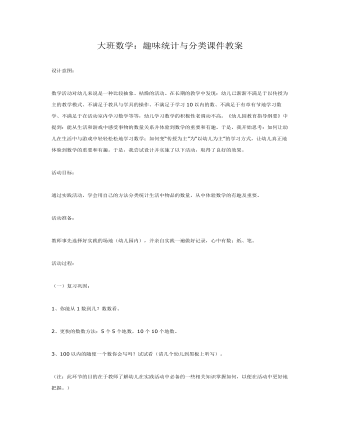
大班数学:趣味统计与分类课件教案
活动目标:通过实践活动,学会用自己的方法分类统计生活中物品的数量,从中体验数学的有趣及重要。活动准备:教师事先选择好实践的场地(幼儿园内),并亲自实践一遍做好记录,心中有数;纸、笔。活动过程:(一)复习巩固:1、你能从1数到几?数数看。2、更快的数数方法:5个5个地数,10个10个地数。3、100以内的随便一个数你会写吗?试试看(请几个幼儿到黑板上听写)。(注:此环节的目的在于教师了解幼儿在实践活动中必备的一些相关知识掌握如何,以便在活动中更好地把握。)(二)联 系生活:1、在生活中,你碰到什么东西要用数来数?举例子。2、在幼儿园里也藏了许多数,请小朋友们说说。3、用什么方法统计方便?(每5个或10个记录一次,然后5个5个或10个10个地数;列表统计等)
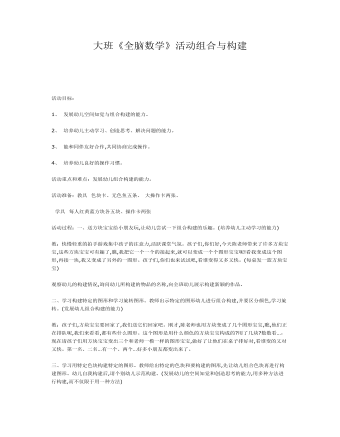
大班全脑数学:组合与构建课件教案
2、 培养幼儿主动学习、创造思考、解决问题的能力。3、 能和同伴友好合作,共同协商完成操作。4、 培养幼儿良好的操作习惯。活动重点和难点:发展幼儿组合构建的能力。活动准备:教具 色块卡、无色鱼五条、大操作卡两张、 学具 每人红黄蓝方块各五块、操作卡两张活动过程:一、送方块宝宝给小朋友玩,让幼儿尝试一下组合构建的乐趣。(培养幼儿主动学习的能力)教:快慢轻重的拍手游戏集中孩子的注意力,活跃课堂气氛。孩子们,你们好,今天陈老师带来了许多方块宝宝,这些方块宝宝可有趣了,瞧,我把它一个一个的接起来,就可以变成一个个图形宝宝呢!看我变成这个图形,再接一块,我又变成了另外的一图形。孩子们,你们也来试试吧,看谁变得又多又快。(每桌发一篮方块宝宝)观察幼儿的构建情况,询问幼儿所构建的物品的名称,向全班幼儿展示构建新颖的作品。
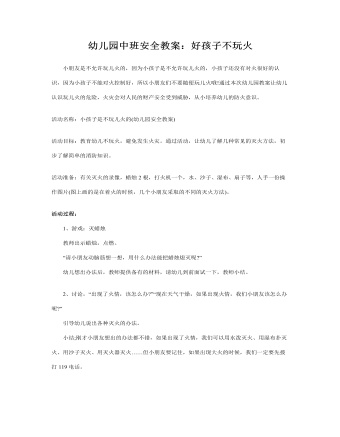
幼儿园中班安全教案:好孩子不玩火
活动目标:教育幼儿不玩火,避免发生火灾。通过活动,让幼儿了解几种常见的灭火方法,初步了解简单的消防知识。活动准备:有关灭火的录像,蜡烛2根,打火机一个,水、沙子、湿布、扇子等,人手一份操作图片(图上画的是在着火的时候,几个小朋友采取的不同的灭火方法)。活动过程:1、游戏:灭蜡烛 教师出示蜡烛,点燃。“请小朋友动脑筋想一想,用什么办法能把蜡烛熄灭呢?” 幼儿想出办法后,教师提供备有的材料,请幼儿到前面试一下,教师小结。
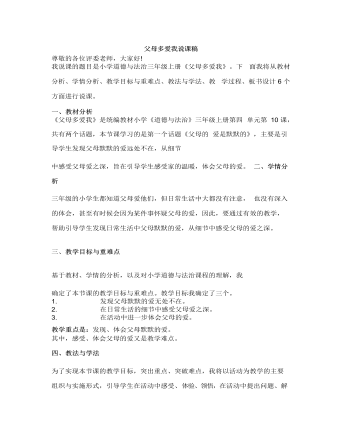
人教部编版道德与法制三年级上册父母多爱我说课稿
活动三:父爱母爱都是爱 在上面的活动基础上,教师引导学生说一说,在你的眼里,妈妈的爱像什么,爸爸的爱又像什么。接着,学生带着这样的爱,一起读 一读教材第 68 页正文中的诗《妈妈的爱》,教师进行总结板书: 父母的爱无处不在设计意图:明白在自己的成长过程中,父爱和母爱同等重要,体 会到父母的爱无处不在。环节三:课堂小结,内化提升 学生谈一谈学习本节课的收获,教师相机引导。设计意图:梳理总结,体验收获与成功的喜悦,内化提升学生的认识与情感。环节四:回归生活,拓展延伸 回家后,以爸爸妈妈的爱为主题写一篇日记。设计意图: 将课堂所学延伸到学生的日常生活中,有利于落实行 为实践。六、板书设计为了突出重点,让学生整体上感知本节课的主要内容,我将以思维导图的形式设计板书:在黑板左半面的中间位置是课题《父母的爱》, 右半面分为三行,上面是默默的,中间是深深的,下面是无处不在。
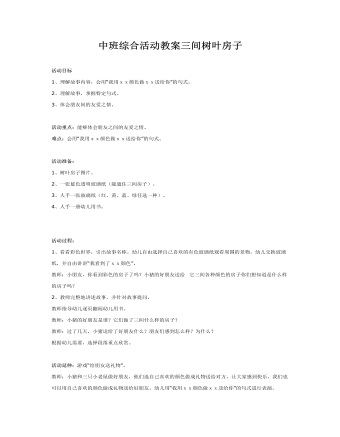
中班综合活动教案三间树叶房子
活动准备:1、树叶房子图片。2、一张蓝色透明玻璃纸(能遮住三间房子)。3、人手一张玻璃纸(红、黄、蓝、绿任选一种)。4、人手一册幼儿用书。 活动过程:1、看看彩色世界,引出故事名称。幼儿自由选择自己喜欢的有色玻璃纸观看周围的景物。幼儿交换玻璃纸,并自由讲讲“我看到了xx颜色”。教师:小朋友,你看到彩色的房子了吗?小猪的好朋友送给 它三间各种颜色的房子你们想知道是什么样的房子吗?
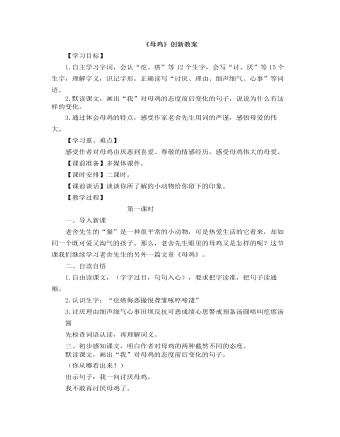
部编人教版四年级下册《母鸡》创新教案
指名学生交流:你选择了是哪个自然段。出示段落(1)不论是在院里,还是在院外,它总是挺着脖儿,表示出世界上并没有可怕的东西。一只鸟儿飞过,或是什么东西响了一声,它立刻警戒起来:歪着头听;挺着身儿预备作战;看看前,看看后,咕咕地警告鸡雏要马上集合到它身边来!你感受到这是一只怎样的母鸡?(勇敢、负责)从文中哪些词语中体会出来。还有同学想说吗?师:从“挺着脖儿、立刻警戒、挺着身儿、咕咕地警告”这些词语我们体会到了勇敢、负责、辛苦的鸡妈妈。现在让我们展开想象的翅膀。想象一下还有哪些情况它立刻警戒起来。(教师口述情境,学生试着说这些词语。)小结:这只母鸡,不论在院里,还是在院外,它总是挺着脖儿。多么负责、勇敢呀!一齐读。
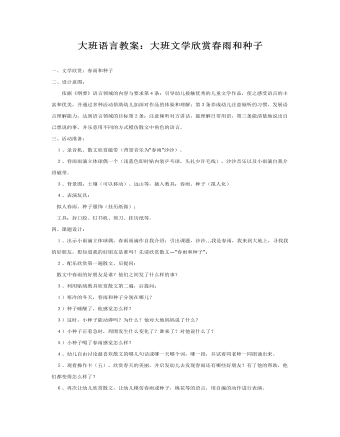
大班语言教案:大班文学欣赏春雨和种子
二、设计意图: 依据《纲要》语言领域的内容与要求第4条:引导幼儿接触优秀的儿童文学作品,使之感受语言的丰富和优美,并通过多种活动帮助幼儿加深对作品的体验和理解;第3条养成幼儿注意倾听的习惯,发展语言理解能力,达到语言领域的目标第2条:注意倾听对方讲话,能理解日常用语,第三条能清楚地说出自己想说的事,并乐意用不同的方式模仿散文中角色的语言。三、活动准备: 1、录音机、散文欣赏磁带(背景音乐为“春雨”沙沙)。 2、春雨雨滴立体球偶一个(浅蓝色即时贴内装乒乓球,头扎少许毛线),沙沙音乐以及小雨滴自我介绍磁带。 3、背景图:土壤(可以移动)、远山等,插入教具:春雨、种子(拟人化) 4、表演玩具: 拟人春雨、种子服饰(挂历纸做); 工具:封口胶、钉书机、剪刀、挂历纸等。
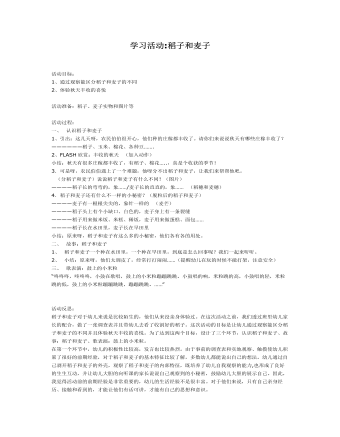
中班科学课件教案:稻子和麦子
2、体验秋天丰收的喜悦 活动准备:稻子、麦子实物和图片等 活动过程: 一、 认识稻子和麦子 1、引出:这几天呀,农民伯伯很开心,他们种的庄稼都丰收了。请你们来说说秋天有哪些庄稼丰收了? ——————稻子、玉米、棉花、各种豆……. 2、FLASH欣赏:丰收的秋天 (加入动作) 小结:秋天有很多庄稼都丰收了,有稻子、棉花…..,真是个收获的季节! 3.可是呀,农民伯伯遇上了一个难题,他呀分不出稻子和麦子,让我们来帮帮他吧。 (分稻子和麦子)说说稻子和麦子有什么不同?(图片) ————稻子长的弯弯的,象……/麦子长的直直的,象…… (稻穗和麦穗)
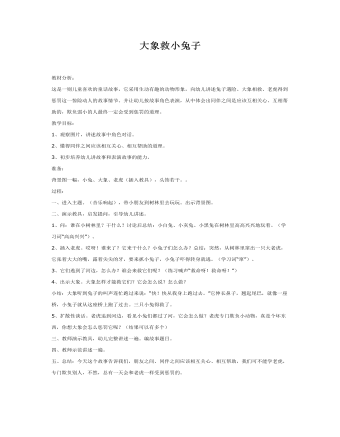
中班语言课件教案:大象救小兔子
教学目标: 1、观察图片,讲述故事中角色对话。 2、懂得同伴之间应该相互关心、相互帮助的道理。 3、初步培养幼儿讲故事和表演故事的能力。 准备: 背景图一幅,小兔、大象、老虎(插入教具),头饰若干。。 过程: 一、进入主题。(音乐响起),带小朋友到树林里去玩玩。出示背景图。 二、演示教具,启发提问,引导幼儿讲述。 1、问:谁在小树林里?干什么?讨论后总结:小白兔、小灰兔、小黑兔在树林里高高兴兴地玩着。(学习词“高高兴兴”)。 2、插入老虎。哎呀!谁来了?它来干什么?小兔子们怎么办?总结:突然,从树林里窜出一只大老虎,它张着大大的嘴,露着尖尖的牙,要来抓小兔子,小兔子吓得转身就逃。(学习词“窜”)。

中班语言课件教案:兔子先生去散步
第一环节,我以兔子的家为导入,看看猜猜,“这是谁的家啊?”让孩子在细致地观察中发现,培养阅读观察的能力。第二环节,是活动的重点,用看图猜谜的活动形式层层引入,根据故事中的标志联想故事的情节。当然在过程中谜底不是绝对的,例如眼泪的那段,也可以是雨滴、水滴、油滴,以引发孩子的讨论。在整个欣赏的过程中注重故事的完整性,在分段欣赏时,从故事开始到“小心坑洞”的那段,内容基本不变,后面的一段留一个疑问,“兔子先生掉到洞里后会碰到什么呢?”引起孩子完整欣赏故事的兴趣,在完整欣赏时了解答案。 第三环节,注重将文学作品回归到孩子的生活中。引导孩子交流讨论生活周围的图象与符号,自然引入社会认知的活动,活动有可持续发展的价值,如延伸活动“寻找生活中的标志、幼儿园、马路上的标志等等。
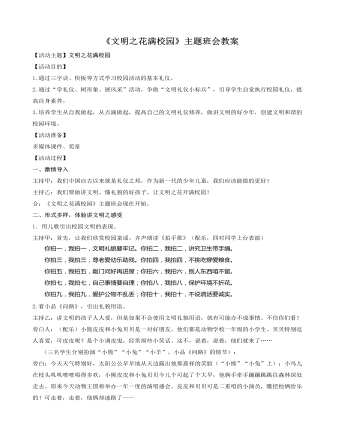
《文明之花满校园》主题班会教案
二、形式多样,体验讲文明之感受1.用儿歌引出校园文明的表现。主持甲:首先,让我们欣赏校园童谣。齐声朗读《拍手歌》(配乐,四对同学上台表演)2.看小品《问路》,引出礼貌用语。主持乙:讲文明的孩子人人爱,但是如果不会使用文明礼貌用语,就有可能办不成事情。不信你们看!旁白人:(配乐)小熊皮皮和小兔贝贝是一对好朋友。他们都是动物学校一年级的小学生。贝贝特别逗人喜爱,可皮皮呢?是个小调皮鬼,经常闹些小笑话。这不,说着,说着,他们就来了……(三名学生分别扮演“小熊”“小兔”“小羊”,小品《问路》的情节):旁白:今天天气特别好,太阳公公早早地从天边露出他那慈祥的笑脸(“小熊”“小兔”上);小鸟儿在枝头叽叽喳喳唱得多欢,小熊皮皮和小兔贝贝今儿个可起了个大早,他俩手牵手蹦蹦跳跳往森林深处走去。原来今天动物王国将举办一年一度的演唱盛会。皮皮和贝贝可是二重唱的小演员,瞧把他俩给乐的!可走着,走着,他俩却迷路了——
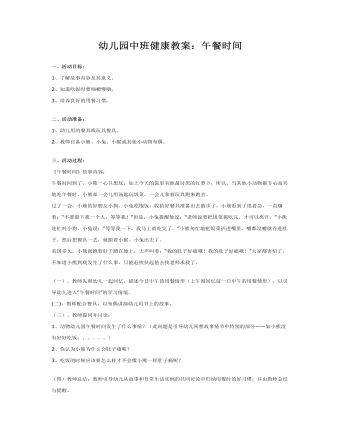
幼儿园中班健康教案:午餐时间
2、知道吃饭时要细嚼慢咽。 3、培养良好的用餐习惯。二、活动准备: 1、幼儿用的餐具或玩具餐具。 2、教师自备小熊、小兔、小猴或其他小动物布偶。三、活动过程: 《午餐时间》故事内容; 午餐时间到了,小熊一心只想玩,加上今天的饭里有他最讨厌的红萝卜,所以,当其他小动物都专心高兴地吃午餐时,小熊却一会儿用汤匙玩饭菜,一会儿拿着玩具跑来跑去。 过了一会,小熊的好朋友小狗、小兔吃饱饭,收拾好餐具准备出去散步了。小熊看到了很着急,一直嚷着:“不要留下我一个人,等等我!”但是,小兔提醒他说:“老师说要把饭菜都吃完,才可以离开。”小熊连忙对小狗、小兔说:“等等我一下,我马上就吃完了。”小熊匆忙地把饭菜扒进嘴里,嚼都没嚼就吞进肚子。然后把餐具一丢,就跟着小猴、小兔出去了。 美国多久,小熊就抱着肚子蹲在地上,大声叫着:“我的肚子好痛哦!我的肚子好痛哦!”大家都害怕了,不知道小熊到底发生了什么事,只能赶快扶起他去找老师求救了。(一)、教师先和幼儿一起回忆、描述今日中午的用餐情形(上午则回忆前一日中午的用
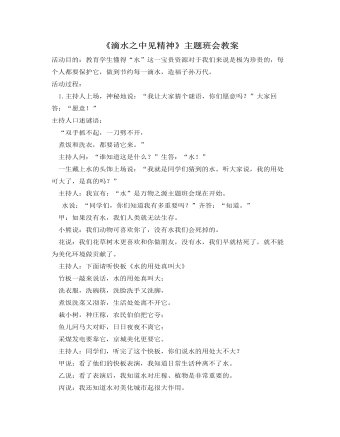
《滴水之中见精神》主题班会教案
主持人:下面请听快板《水的用处真叫大》竹板一敲来说话,水的用处真叫大;洗衣服,洗碗筷,洗脸洗手又洗脚,煮饭洗菜又沏茶,生活处处离不开它。栽小树,种庄稼,农民伯伯把它夸;鱼儿河马大对虾,日日夜夜不离它;采煤发电要靠它,京城美化更要它。主持人:同学们,听完了这个快板,你们说水的用处大不大?甲说:看了他们的快板表演,我知道日常生活种离不了水。乙说:看了表演后,我知道水对庄稼、植物是非常重要的。丙说:我还知道水对美化城市起很大作用。2.主持人:水有这么多用处,你们该怎样做呢?(1)(生):我要节约用水,保护水源。(2)(生):我以前把水壶剩的水随便就到掉很不对,以后我一定把喝剩下的水倒在盆里洗手用。(3)(生):前几天,我看到了学校电视里转播的“水日谈水”的节目,很受教育,同学们看得可认真了,知道了我们北京是个缺水城市,我们再不能浪费水了。(4)(生):我要用洗脚水冲厕所。
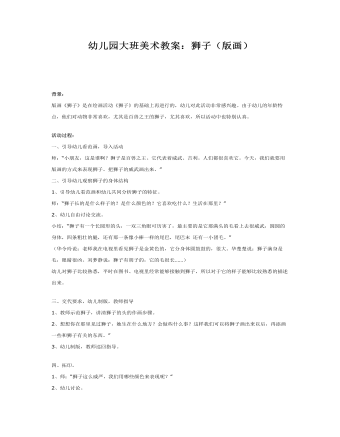
幼儿园大班美术教案:狮子(版画)
活动过程:一、引导幼儿看范画,导入活动 师:“小朋友,这是谁啊?狮子是百兽之王。它代表着威武、吉利。人们都很喜欢它。今天,我们就要用版画的方式来表现狮子。把狮子的威武画出来。” 二、引导幼儿观察狮子的身体结构 1、引导幼儿看范画和幼儿共同分析狮子的特征。 师:“狮子长的是什么样子的?是什么颜色的?它喜欢吃什么?生活在那里?” 2、幼儿自由讨论交流。 小结:“狮子有一个长圆形的头,一双三角眼可历害了,最主要的是它那满头的毛看上去很威武,圆圆的身体,四条粗壮的腿,还有那一条像小棒一样的尾巴,尾巴末还有一小团毛。” (华令玲说:老师我在电视里看见狮子是金黄色的,它分身体圆鼓鼓的,很大。华楚楚说:狮子满身是毛,眼睛很凶。刘梦静说:狮子有胡子的,它的毛很长……) 幼儿对狮子比较熟悉,平时在图书、电视里经常能够接触到狮子,所以对于它的样子能够比较熟悉的描述出来。
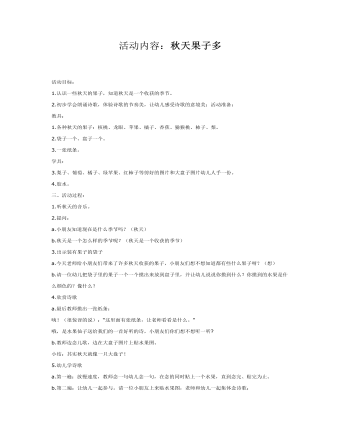
中班科学课件教案:秋天果子多
2.初步学会朗诵诗歌,体验诗歌的节奏美,让幼儿感受诗歌的意境美;活动准备:教具:1.各种秋天的果子:核桃、龙眼、苹果、橘子、香蕉、猕猴桃、柿子、梨。2.袋子一个、盘子一个。3.一张纸条。 学具:3.梨子、葡萄、橘子、绿苹果、红柿子等剪好的图片和大盘子图片幼儿人手一份。4.胶水。三、活动过程:1.听秋天的音乐。2.提问:a.小朋友知道现在是什么季节吗?(秋天)

